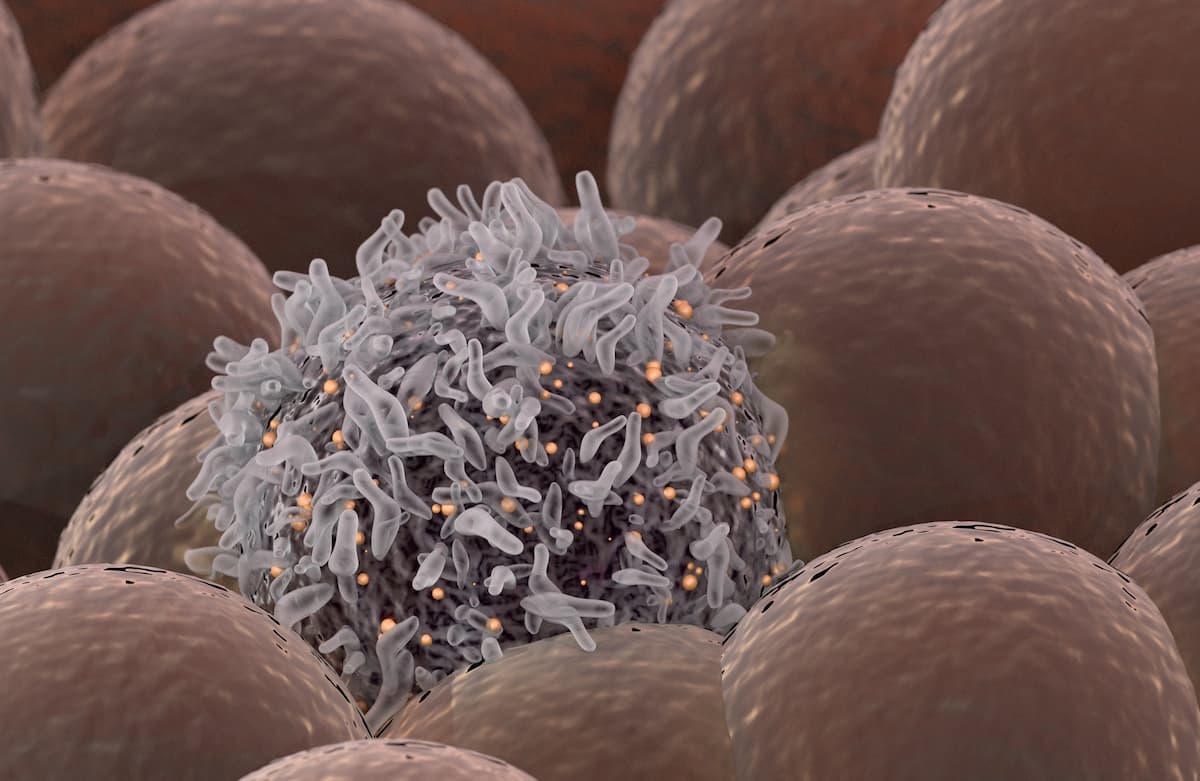Atezolizumab Combo Results in Intracranial Activity in BRAFV600+ Melanoma
Second-line end points of the TRICOTEL trial assessing atezolizumab plus vemurafenib and cobimetinib in melanoma with central nervous system metastases appear consistent with primary efficacy end points.
Investigators reported that treatment-emergent adverse effects (TEAEs) occurred in every patient who was treated with the triplet, with grade 3 or higher treatment-related AEs occurring in 68%.

A triplet regimen consisting of atezolizumab (Tecentriq) plus vemurafenib (Zelboraf) and cobimetinib (Cotellic) demonstrated intracranial activity in a population of patients with BRAFV600–mutant melanoma and central nervous system (CNS) metastases, according to data from the phase 2 TRICOTEL trial (NCT03625141).
For patients with BRAFV600–positive and wild-type disease, the overall response rate (ORR) by investigator assessment was 42% (95% CI, 29%-54%) and 27% (95% CI, 8%-55%), respectively, with a median follow-up of 9.7 months (Interquartile range [IQR], 6.3-15.0) and 6.2 months (IQR, 3.5-23.0).
In the BRAFV600–mutant group, the median intracranial duration of response (DOR) was 7.4 months (95% CI, 5.7-11.0) by independent review committee (IRC) assessment and 5.7 months by investigator assessment. Moreover, 78% of patients experienced progressive disease or death by IRC and 74% by investigator assessment.
The multicenter, open-label, single-arm study was conducted at 21 hospitals in several countries, including France, Germany, Hungary, Italy, Spain, and Switzerland. To be included in the study, patients needed to be 18 years or older with histologically confirmed disease and brain metastases at least 5 mm or more that were confirmed via MRI measuring. Patients were also not able to have undergone prior systemic therapy for metastatic disease and needed an ECOG performance status of 0 to 2 to enroll. Additional inclusion criteria were a life expectancy of 3 months or greater, and adequate hematologic and end organ function.
Exclusion criteria included having an increasing corticosteroid dose 7 days prior to starting treatment or receiving a current dexamethasone or equivalent dose of over 8 mg daily. Receipt of a prior BRAF or MEK inhibitor, immunotherapeutic, or whole brain radiotherapy and having notable or uncontrolled comorbidities were also grounds for exclusion.
Study treatment consisted of 840 mg of intravenous atezolizumab on days 1 and 15 plus 60 mg of oral cobimetinib daily on days 1 to 21 in the wild-type cohort. In the BRAFV600 mutation cohort, patients were treated with the same atezolizumab and cobimetinib combination plus 720 mg of vemurafenib twice a day; atezolizumab was withheld during cycle 1. Treatment went on until progressive disease, death, unacceptable toxicity, withdrawal of consent, or pregnancy.
The TRICOTEL’s primary end point was intracranial ORR by IRC assessment, with secondary end points including ORR by investigator assessment, extracranial ORR, DOR, overall survival, safety, and quality of life.
A total of 80 patients enrolled on the study from December 2018 to December 2020, of whom 65 were included in the BRAFV600–mutant population. Forty percent of the population had symptomatic CNS metastases at baseline; of this population, 11 were receiving corticosteroids, 8 were receiving levetiracetam, and 19 had brain-related symptoms. Patients with symptomatic lesions were noted as having a higher intracranial tumor burden compared with the asymptomatic population (n = 39).
In the mutation cohort, investigators reported a median intracranial progression-free survival (PFS) was 5.3 months (95% CI, 3.8-7.2) by IRC assessment and 5.6 months (95% CI, 5.4-7.4) by investigator assessment.
Investigators also assessed responses in patients with symptomatic and asymptomatic CNS metastases as part of a post-hoc analysis, with a median follow-up of 7.8 months (IQR, 4.5-11.5) and 11.1 months (IQR, 7.9-17.5). The intracranial ORR was 35% (95% CI, 17%-56%) by IRC and 38% (95% CI, 20%-59%) by investigator assessment in the symptomatic group (n = 26). The median DORs were 7.4 months (95% CI, 3.8-not estimable) and 6.1 months (95% CI, 4.8-13.8), respectively. The corresponding ORRs in the asymptomatic cohort, respectively, was 46% (95% CI, 30%-63%) and 56% (95% CI, 40%-72%). The median DORs in this group were 7.6 months (95% CI, 6.2-12.7) and 5.6 (95% CI, 5.5-7.6), respectively.
In the symptomatic cohort, intracranial disease progression or death was observed in 85% by IRC and investigator assessment, respectively. Median PFS by IRC and investigator assessment was 4.5 months (95% CI, 2.3-6.9) and 5.1 months (95% CI, 3.7-6.9), respectively. For those with symptomatic CNS metastases, the intracranial progression or death was observed in 74% of patients by IRC and 67% by investigator assessment. Moreover, the median intracranial PFS was 5.5 months (95% CI, 3.8-8.4) and 7.2 months (95% CI, 5.4-9.2), respectively.
Investigators reported that treatment-emergent adverse effects (TEAEs) occurred in every patient who was treated with the triplet, with grade 3 or higher treatment-related AEs occurring in 68%. Frequent high-grade toxicities included lipase increase (25%) and blood creatine phosphokinase increase (18%).
Additionally, grade 3 or higher AEs of special interest, which occurred in 62% of patients, included pancreatitis (28%), hepatitis (20%), elevated creatine phosphokinase (18%), and rash (17%). A total of 30% of patients discontinued due to AEs.
Reference
Dummer R, Queirolo P, Dunhard PG, et al. Atezolizumab, vemurafenib, and cobimetinib in patients with melanoma with CNS metastases (TRICOTEL): a multicentre, open-label, single-arm, phase 2 study. Lancet Oncol. Published online July 14, 2023. doi:10.1016/S1470-2045(23)00334-0